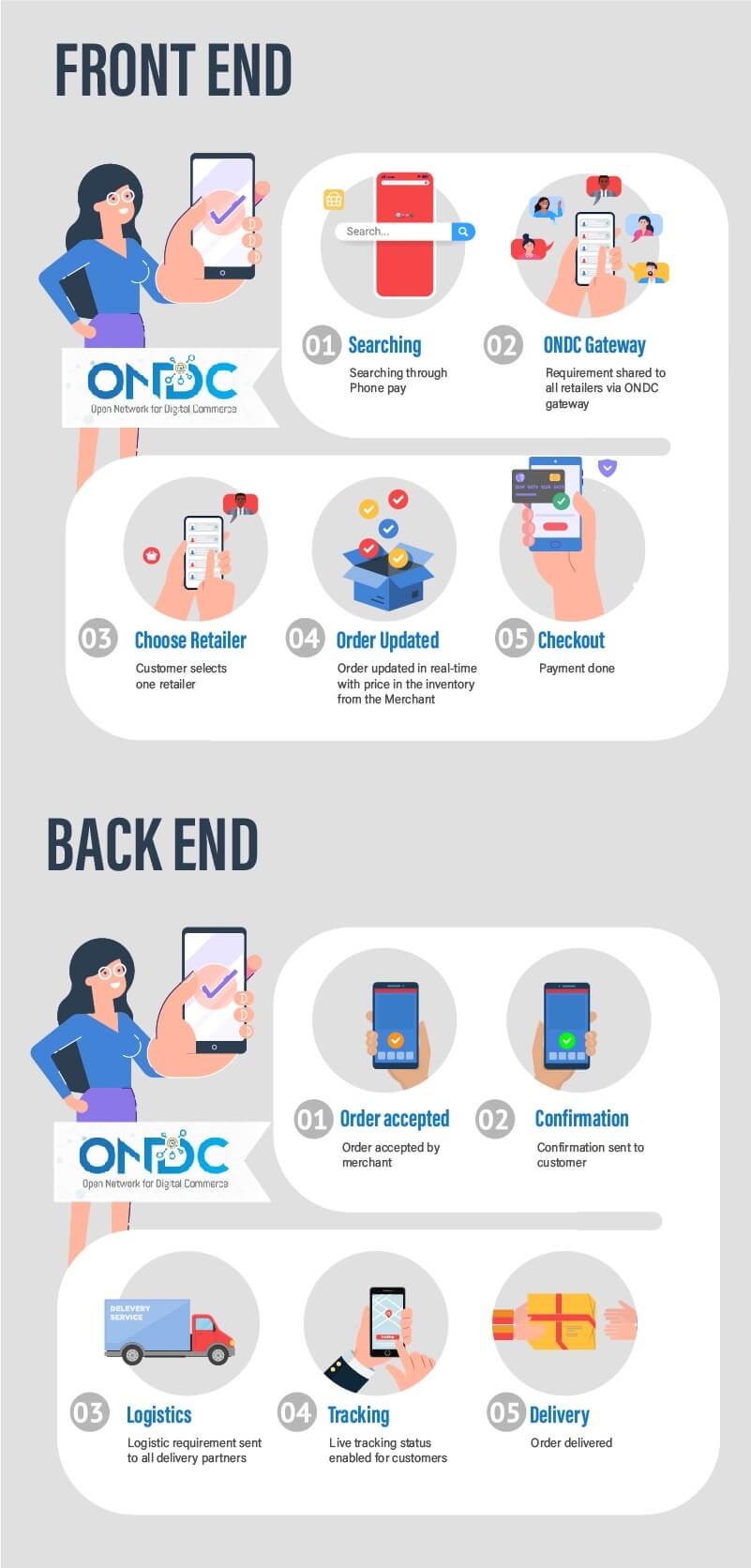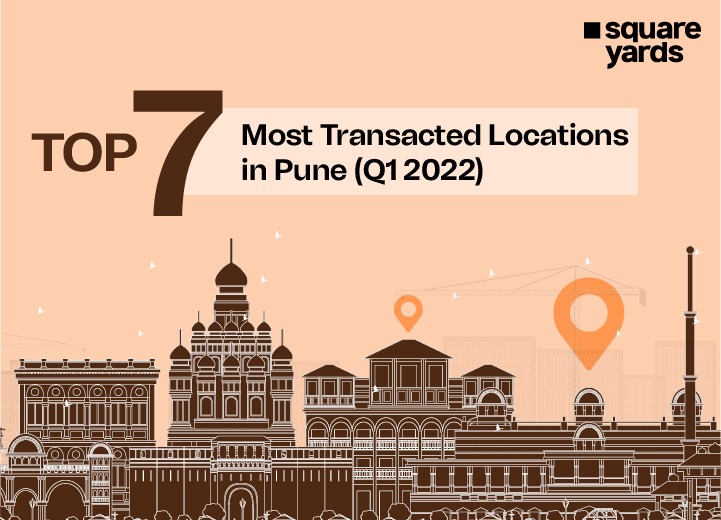What if you can use one gateway to access all apps and buy anything you want? No multiple downloads or logins. The government owned ONDC project would enable you to do just that.
On April 29, 2022, its pilot phase launched in five metropolitan cities of Delhi NCR, Bengaluru, Bhopal, Shillong and Coimbatore. The plan is to add around 150 retailers in the pilot phase of ONDC. Speculations are now running high that the ONDC will soon smash the persisting monopoly of e-commerce giants like Amazon, Flipkart and Zomato.
ONDC is a non-profitable, open gateway that got integrated into the private sector on December 31, 2021. This open protocol holds power to democratise the e-commerce industry in India.
The Department for Promotion of Industry and Internal Trade (DPIIT) cultivated ONDC at the Quality Council of India. ONDC is designed and accelerated by a nine-member advisory council. One of the main motives behind ONDC is to provide a fair chance to all the local SMEs and retailers to regain their business potential and profit.
|
The Current Status of the E-Commerce Market in India
|
Table of contents
- Open Network for Digital Commerce – What is it?
- How Does ONDC Work?
- 3 Major Problems The ONDC Aims to Resolve
- How is ONDC Profitable to Buyers and Sellers in India?
- What is the Significance of ONDC in India?
- Who Has Joined ONDC So Far?
- Who Are the Key Stakeholders to the ONDC?
- Will ONDC Prove to be a Robust Step After All?
Open Network for Digital Commerce – What is it?
ONDC is a government-initiated, freely accessible open gateway incorporated to assist micro and small local businesses via e-commerce. Though it is still in an inceptive stage, it holds the potential to skyrocket the efficacy of its functional operations via more visibility, robust interoperability and fair pricing. The drive behind making this Open Network for Digital Commerce protocol is to smash the superiority of e-commerce titans like Amazon and Flipkart in India.
How Does ONDC Work?
ONDC will allow customers to access sellers using any application integrated with the ONDC network.
The example in the following infographic displays the working model of the ONDC gateway both from the front end and the back end.

3 Major Problems The ONDC Aims to Resolve
Here are the three major issues in today’s e-commerce market that the ONDC wishes to address and amend.
The Monopolising Model of E-Commerce
The e-commerce market primarily functions on two models: the marketplace model and the inventory model. In the marketplace model, the company only works as a platform wherein sellers and buyers are independent components.
However, in the inventory model, the company buys the products in bulk at dirt-cheap prices and sells them at higher prices. In this case, even though sellers receive exposure on the platforms, the company reaps major profits, especially with expensive or luxury products, like gadgets, appliances, etc.
Using this model, therefore, e-commerce companies monopolise their positions in the market for better accessibility and exposure to both sellers and buyers using their platforms. This further limits the growth of any other micro or small businesses and brick-and-mortar stores.
see also@ GST Bill: Impact, Amendments and Updates
Deep Discounting
We are all aware of this one. Especially when any of the e-commerce platforms announce Summer Sale, Diwali Sale, Christmas Sale, etc. To put it straight, deep discounting is a discount rate or amount that is higher than usually offered.
While these attract customers like moths to a flame, it pushes small businesses to lower their prices to the point that their businesses shut down. Even though, in the age of accessibility, we might feel that online shopping, in general, is convenient, to the government, offline businesses still matter.
So, through ONDC, the government aims to bring these businesses to the forefront and give them their due spotlight and profit.
E-Commerce Imitation
It goes without saying that the big players in the e-commerce market have exhaustive seller and buyer data. Analysing this, they not only get to know about all the whens and what’s of the highest purchases but also customer preferences.
This enables e-commerce giants to create products that have the same attractive feature as any other products being sold on their platform. Prices are also manipulated accordingly, which results in further monopolising the market, pushing down other sellers.
But with a single integrated platform of ONDC, there is a high chance that this nuance will be under control or completely done away with.
Other Conundrums of the E-Commerce Market
The other reasons behind the incubation of Open Network for Digital Commerce is to reduce and avoid the following factors faced by both the buyers and the sellers:
- Hefty commissions
- Delivery cost
- Price undercutting issues
- Data sharing
- Data theft
- Unhealthy competition between small scale and large scale businesses
How is ONDC Profitable to Buyers and Sellers in India?
ONDC is a transaction-centric model. In other words, what UPI is to payments is what ONDC is to e-commerce.
With ONDC, it does not matter which app the seller or the buyer uses. The only thing that matters is their online availability. As long as the buyer and seller are inter-connected on any app through the ONDC network, they can perform transactions between them. It is more like using Phonepe to scan a code within the Paytm app.
| Piyush Goyal, our Union Minister for Commerce and Industry said that after UPI, ONDC is another game-changing idea to democratise commerce. It will bring consumers, sellers and logistics providers togethers. |
Further, the approach of the Indian government towards ONDC is not as an app for buyers or sellers. Instead, they have made ONDC an open portal around which numerous apps will be built by third parties.
However, the ONDC tech partners may launch some apps for buyers and sellers in the initial days. Another good part is the availability of the third-party logistic partners depending on the region and order type.
Apart from the reasons mentioned above, let’s know how ONDC is profitable to both the sellers and buyers individually.
Sellers
- For sellers, the profit margins will increase since there is no deduction of commission.
- The growth potential of value-added services in the logistic sector and other sectors will increase rapidly.
- All the sellers, irrespective of their business scale or location, will get instant visibility on a network with numerous buyer and seller apps.
- Sellers will not be bound by the regulation of any particular app or platform like Zomato or Amazon.
- All micro and small sellers will be able to access more buyers and attain more data at a lower cost. It will help in pulling down the barrier of using five different apps online.
Buyers
- Buyers will have more options to choose from as they are being offered better prices and easy access to all local retailers without the need for downloading multiple apps.
- Buyers will have a third-party delivery partner to fulfil their orders or even the sellers.
- Buyers can also choose their delivery partner as per their preference.
- A buyer who wants to buy some onions or potatoes will have the option of choosing their seller.
What is the Significance of ONDC in India?
With ONDC, India is expected to digitise and democratise the e-commerce platform offering an equal growth opportunity for all businesses. The following points clearly describe the positive impact of ONDC in the Indian market and on small scale sellers and buyers.
| The additional secretary of DPIIT, Anil Agarwal, stated that – From the pilot phase of ONDC, they could observe and learn how it will impact the real-life environment. They will monitor how consumers will pay, deliveries will happen, orders will be cancelled, refunds will be processed, and others. Once they know how it is going, they will make a final draft of the operations to use them as a set of standards. |
- ONDC will digitise the complete process of ordering and delivering goods and services. From the value chain and operations to the involvement of suppliers, logistics efficiency and quality buyers expansion.
- It is expected that by August 2022, ONDC will be fully integrated. All e-commerce companies then have to operate using similar processes affiliated with android mobile phones irrespective of brand.
- ONDC will provide a fair chance for all small online retailers to grow. It will also increase selling chances for new entrants by assisting them in discovering new things, manageable internal operations and involvement in every process.
- ONDC will empower and encourage suppliers as well as consumers. A surge in local businesses can potentially transform and drive innovation in all sectors, like food, travel, hotel, mobility, etc.
- All the businesses are envisioned to earn profit from transparency, little investments, and lower business acquisition costs. Time-to-market and time-to-scale are also expected to decrease.
- The Indian government predicted India’s e-commerce market to grow and reach US $200 billion by 2027. It looks promising enough to engage all types of business contenders.
These powerful impacts of ONDC are enough to surpass the giant e-commerce platform and grow the nation’s GDP and the value of the Rupee currency in the market.
Who Has Joined ONDC So Far?
As per reports, the logistic team Ekart of Flipkart and Reliance Retail backed Dunzo has merged with the Open Network for Digital Commerce for logistic services. Further, PhonePe (owned by Walmart and Flipkart) has joined the network. It is also heard that PhonePe is in the advanced stages of the integration process. However, Paytm is already a part of the Open Network for Digital Commerce.
| eSamudaay, ERP player Gofrugal, digital marketing company Growth Falcon, and analytics firm Sellerapp all are ready to work with ONDC sellers and a new agency, as reported by PTI. |
Who Are the Key Stakeholders to the ONDC?
The key stakeholders who have shown their interest in the ONDC project are mentioned below.
- Around 20 government and private organisations have invested INR 2.55 billion in the ONDC Project. It is equivalent to 33.34 million US dollars.
- Many public and private sector banks have picked up the stakes in ONDC.
- Banks like Kotak Mahindra Bank, State Bank of India, Axis Bank and HDFC have acquired a share of 7.84% each and invested INR 100 million to purchase 10,00,000 equity shares of the face value of INR 100 each.
- Punjab National Bank earlier in 2021 November announced its plans to buy a 9.5% share in ONDC further.
- As per The Economic Times report, “Around 80 companies are trying to integrate the market players with the ONDC platform. These companies are making enterprise software, apps for sellers and buyers, logistic platforms and payment gateways”.
- The reports of The Business Standard stated that 24 firms, including high profile startups (Like Ekart Logistics, Dunzo and PhonePe), are integrating with ONDC.
- As of May 15 2022, one buyer platform, five seller platforms and one logistic partner have become a part of the ONDC pilot programme.
- Paytm E-Commerce Private Limited (parent company of Paytm Mall) will be hinging on ONDC as their prominent focus. PEPL is also determined to explore more business opportunities. Further, PEPL will drop its foreign investors like Alibaba and Ant Group over the change in the business direction.
- Google is also in talks with ONDC to integrate its shopping services. As of now, Google does not take orders or deliveries like other e-commerce platforms. This was reported by Reuters on May 27, 2022.
| Anil Agarwal said, going forward, ONDC will onboard three crore sellers and one crore retail merchants online. In the next six months, ONDC will reach 100 cities. |
see also@ The Global Real Estate Commercial Markets Series – Part 3, Asia Pacific
Will ONDC Prove to be a Robust Step After All?
The ONDC is a one-of-a-kind government initiative. It not only aims to offer equal opportunities for all micro and small businesses but ensures convenience and fairness for buyers. Currently, in its pilot phase, it has already garnered significant attention from multiple investors and participants. Even though the open gateway of ONDC is speculated to uproot the dominance of e-commerce giants, there are still a few doubts questioning its implementation.
The ONDC is an online open gateway, and one of the problems with anything digital is its screen space. The algorithm of online product listing always follows the descending order wherein the product with the highest reviews or sales is shown at the top. So, even though ONDC promises to promote micro and small businesses, it is still not clear how it will offer visibility to them when other online products occupy the first page.
To make things more even in the e-commerce market, the government is also blocking multiple avenues of profit for household names like Zomato. According to the government, being a food delivery company, Zomato will not be able to open a restaurant now or in the future as it would seem anti-competitive.
This will not only create disinterest amongst the big fishes in the market but a downright apathy against ONDC. And it is yet to be seen how the government is going to tackle these issues to promote equanimity in the market.





































